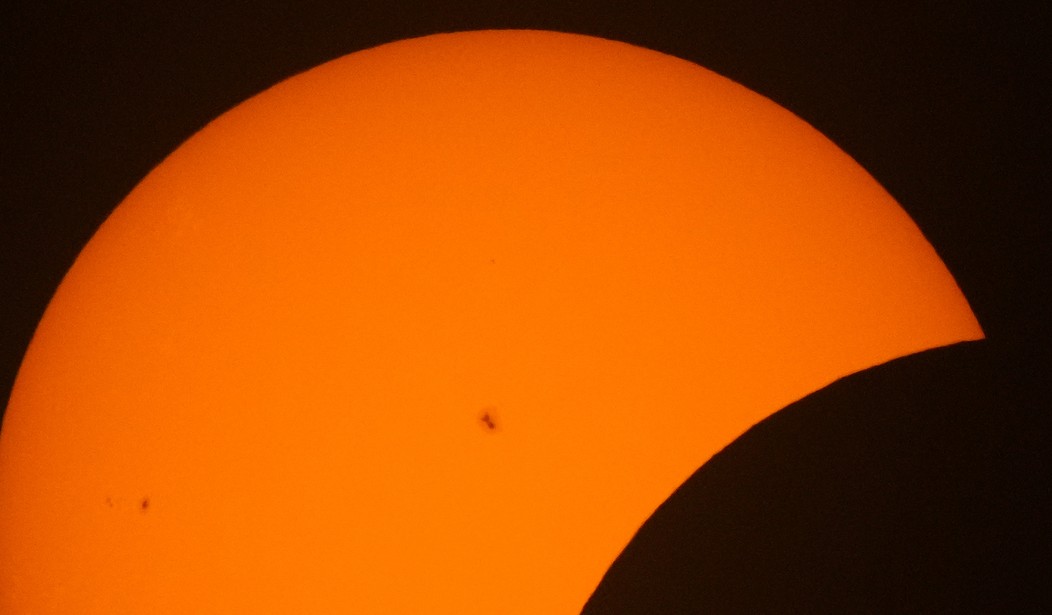America witnessed a couple of notable eclipses on Monday: the "total eclipse of Joe Biden's shame" during a student debt relief speech the POTUS gave in Wisconsin and the total solar eclipse which saw several states in the path of totality, which is "the area where the moon will fully block out the sun," per NASA:
About 31.6 million people live in the path of totality, the area where the moon will fully block out the sun, according to NASA. The path will range between 108 and 122 miles wide. An additional 150 million people live within 200 miles of the path of totality.
[...]
While the April 8 eclipse will cover a wide swath of the U.S., outside the path of totality observers may spot a partial eclipse, where the moon covers some, but not all, of the sun, according to NASA. The closer you are to the path of totality, the larger the portion of the sun that will be hidden.
Here's what it looked like in some parts of the country. Just amazing:
The Total Solar Eclipse in Cleveland, OH pic.twitter.com/73epVTuBpX
— Gabe Wasylko (@GabeWasylko) April 8, 2024
Time lapse of the solar eclipse at GABP 😍
— FOX Sports: MLB (@MLBONFOX) April 8, 2024
(via @Reds)pic.twitter.com/NZ1UOjSUtB
The moment the total solar eclipse shrouded Niagara Falls in darkness 😦 pic.twitter.com/Lc6v21Hfgd
— News 4 Buffalo (@news4buffalo) April 8, 2024
"Diamond ring" formed during total solar eclipse in Carbondale, IL. pic.twitter.com/AY5HfkZ9AL
— New York Post (@nypost) April 8, 2024
It wasn't as intense here in Charlotte, where we saw 80 percent totality at 3:11 pm ET, with the sky looking abnormally dark blue and stormy for several minutes.
Favorite line from the eclipse:
— Rachel Coulter WBTV (@Coulter_wx) April 8, 2024
*baby cries*
Baby’s mom: “It’s okay it’s not bedtime”
… I just wish that lasted forever. Just too beautiful. The way God made all this work… unbelievable. @WBTV_News pic.twitter.com/RfxpFi1uhs
During the last total solar eclipse this continent could view, which was in the summer of 2017, the path of totality included parts of the Carolinas. I remember having my glasses on at the time looking at the little half-moons all over the ground and thinking how cool it was. I didn't get any of those special glasses this time around, but I'm kind of wishing I had.
Something else cool was the way NASA's Moon Twitter account reacted to the Monday eclipse, writing that they had "blocked" the NASA Sun Twitter account "again":
Oops I did it again 🤭 #TotalSolarEclipse pic.twitter.com/JXPe26qq3Q
— NASA Moon (@NASAMoon) April 8, 2024
As of this writing, NASA Sun hasn't responded; presumably, they're filing a harassment complaint with the appropriate authorities. ;)
By the way, the next total solar eclipse that should be visible in the United States is predicted to occur 20 years from now, on August 23, 2044. It reportedly "will begin in Greenland, sweep through Canada and end around sunset in Montana, North Dakota and South Dakota."
A year after that, a "coast to coast" total solar eclipse is expected.
Related-->> 'Inept Organization': Cringe Meters Explode After Amtrak Twitter Account Goes Woke on Climate Change














Join the conversation as a VIP Member